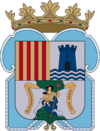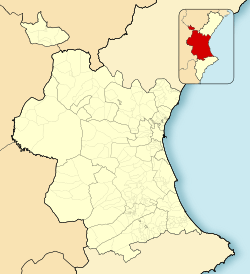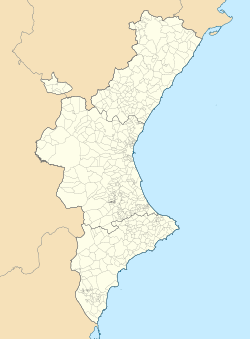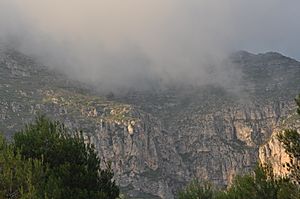Barx facts for kids
Quick facts for kids
Barx
|
||
|---|---|---|
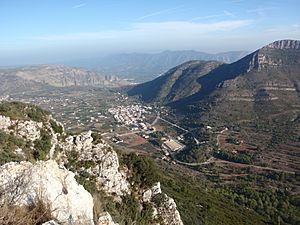 |
||
|
||
| Country | ||
| Autonomous community | ||
| Province | Valencia | |
| Comarca | Safor | |
| Judicial district | Gandia | |
| Area | ||
| • Total | 16.1 km2 (6.2 sq mi) | |
| Elevation | 325 m (1,066 ft) | |
| Population
(2018)
|
||
| • Total | 1,229 | |
| • Density | 76.34/km2 (197.7/sq mi) | |
| Time zone | UTC+1 (CET) | |
| • Summer (DST) | UTC+2 (CEST) | |
| Postal code |
46758
|
|
| Official language(s) | Spanish, Valencian | |
Barx, also known as Bárig, is a small town in Spain. It is located in the Valencian Community, a region famous for its beautiful scenery. Barx is part of the Safor area, which is a comarca (a type of region) in the province of Valencia. It sits high up in the mountains, about 325 meters (1,066 feet) above sea level. In 2018, about 1,229 people lived there.
What's in a Name? The Story of Barx
The name "Barx" has a long and interesting history. Experts have debated where it came from. Some believe the name comes from an old Moorish phrase, Bodj Aldjabal, which means "tower of the mountains." This suggests a strong, high place.
Other scholars think the name comes from an older Christian word, Perxe. This word meant "cabin." Over time, it might have changed to Berxe because of how Arabic was spoken. So, whether it was a "tower" or a "cabin," the name shows that people have lived in Barx for a very long time, possibly over a thousand years.
Barx is quite isolated because of its mountain location. This has made the community unique. People here have a strong sense of "cultural independence." They like to connect with the outside world but also value their peaceful, isolated home. This special location helps us understand the past and present of Barx.
Ancient Times: Who Lived Here First?
The area around Barx has a very old history. Two important caves, Parpalló (near Gandia) and Malladetes (in Barx), show this. These caves contain amazing archaeological finds. They tell us that people lived here without interruption for a long time. This was from about 29,000 years ago until 11,000 years ago.
These early people were hunter-gatherers. This means they hunted animals and collected plants for food. They were very skilled at making tools. They used both stone and bone to create useful items.
One of the most special things about the Parpalló cave is its collection of ancient art. There are many cave paintings and carvings on limestone. These artworks show animals and other interesting scenes. They prove that the people living here long ago had great artistic talent. They also had a rich symbolic culture.
See also
 In Spanish: Bárig para niños
In Spanish: Bárig para niños


